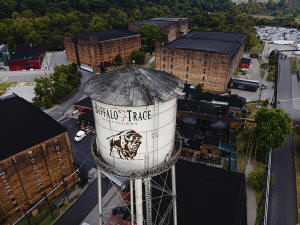Kentucky distillery bounces back from massive flood that briefly halted
bourbon production
[September 24, 2025]
By BRUCE SCHREINER
FRANKFORT, Ky. (AP) — The long history of bourbon production at Buffalo
Trace Distillery has been connected to the Kentucky River — summed up as
a blessing and curse by a plaque on the grounds.
In the 1800s, long before the Buffalo Trace name was attached to the
distillery, the river served as a floating highway to bring in grain and
other production essentials and to transport barrels of whiskey to
markets along the Ohio and Mississippi rivers. Even today, river water
cools down production equipment. But the river flowing past the
distillery flashed its destructive side in April.
A massive flood, caused by days of unrelenting rain, sent the Kentucky
River surging over its banks, inundating most of the 200-plus-acre
distillery grounds on its main campus in Frankfort. Nearly every phase
of production was impacted, as were several warehouses where whiskey is
aged.
“It was just something that was hard to process, but we knew we couldn’t
take too much time to process it,” said Tyler Adams, a distillery
general manager. He said they had much to do to recover from the
reservoir of murky water that swamped the bourbon-making campus.
Whiskey production bounces back
Five months later, production at the distillery is back to normal,
including of some of the most sought-after bourbons. Its lineup includes
the namesake flagship brand, Buffalo Trace, as well as Eagle Rare, W.L.
Weller and Blanton's. Pappy Van Winkle bourbons are distilled and aged
at Buffalo Trace while the Van Winkle family remains in control of the
coveted brand.

The distillery recently filled its 9 millionth barrel of bourbon since
Prohibition, just two and a half years since filling the 8 millionth
barrel. It has also introduced new whiskeys to its catalogue and is
renovating a campus building into a cafe and events center.
The cleanup enlisted hundreds of plant employees and contract workers.
Buffalo Trace fans swamped the distillery with offers to pitch in, Adams
said. The distillery politely declined and suggested they might assist
area residents instead.
Crews removed debris, sanitized equipment and pumped out what was left
after floodwaters receded. Bourbon barrels swept into the parking lot
caught some attention, Adams said. No chance for sneak samples, though —
the barrels were empty.
Few visible reminders remain of that mud-caked, debris-strewn mess.
Some filled whiskey barrels touched by floodwaters were still being
cleaned and tested, but the meticulous task of examining thousands of
barrels was nearly complete, the distillery said. Quality control
assessments found only small amounts of aging whiskey were impacted.
High water marks are etched into some buildings and tour guides casually
remind visitors of the epic event.
Danny Kahn, a master distiller for Buffalo Trace's parent company, says
he still experiences “a little PTSD” when recalling those frantic days.
River flooding has been a sporadic part of the distillery's history —
including big ones in 1937 and 1978, but in early April, the floodwaters
surged to previously unseen heights. Buffalo Trace had also just
completed a decade-long, $1.2 billion expansion to double distilling
capacity.
“It actually looked kind of calm, but I knew that it was not calm
because we could see buildings were under 10 feet (3 meters) of water,”
Kahn said. “It was really quite overwhelming.”
Activating their flood plans, workers shut down the distillery and did
what they could to safeguard equipment. After that, all they could do
was watch and wait. Distillery officials observed the devastation from
higher ground and via drone footage.
[to top of second column] |

In an aerial view, the Buffalo Trace Distillery is seen on Sept. 16,
2025, in Frankfort, Ky. (AP Photo/Jon Cherry)

Once the river crested, it took a few days for the floodwaters to
fully recede, but operations gradually sprung back to life. Finished
whiskey shipped out the day after the rain stopped. Bottling soon
resumed and a makeshift gift shop opened until the visitors' center
was repaired. Tours eventually resumed. But bourbon production
halted for about a month as the cost for cleanup and repairs
surpassed $30 million.
Several storage tanks shifted off their foundation. Some were
repaired, others replaced. Dozens of electrical control panels were
destroyed. About three-fourths of gift shop inventory was lost.
“It was just defeating to watch all this flooding and to realize
that we’re going to be down for a while,” Kahn said. “Just the
apprehension of how much work this is going to be to fix. And when
we finally got it done, it was really a sigh of relief and we get
back to business as normal.”
Hard times in the whiskey sector
For the American whiskey industry as a whole, it's been anything but
business as usual.
After years of growth, prospects turned sour for the sector amid
sluggish sales and trade uncertainties as President Donald Trump
imposed sweeping tariffs.
In 2024, American whiskey sales in the U.S. fell nearly 2%, the
first such drop in supplier sales in more than 20 years, the
Distilled Spirits Council said. Initial data for the first half of
2025 showed a continued decline, it said. American whiskey exports
dropped more than 13% through July of this year compared to the
year-ago period, it said. The American whiskey category includes
bourbon, Tennessee whiskey and rye whiskey.
Lower domestic sales stem from a mix of market challenges, including
supply chain disruptions and changes in consumer purchasing trends,
said Chris Swonger, the council's CEO.
“While there’s ongoing debate about whether these are temporary
headwinds or signs of a more fundamental shift in consumer behavior,
large and small distilleries across the country are under pressure,”
Swonger said in a statement.
Kentucky distilleries producing such prominent brands as Buffalo
Trace, Jim Beam, Maker’s Mark, Woodford Reserve, Wild Turkey and
Four Roses can weather downturns better than small producers.
Heaven Hill Brands, another large producer, recently celebrated its
new $200 million distillery in Bardstown, Kentucky, taking a long
view of market prospects by significantly boosting bourbon capacity.

“As an independent, family-owned company, we don’t have to chase
quarterly trends; we’re building for the next generation,” said Kate
Latts, co-president of Heaven Hill Brands, whose brands include Evan
Williams and Elijah Craig. “This distillery reflects that
philosophy.”
At Buffalo Trace, its future is entrenched alongside the Kentucky
River, realizing that more floods could come in the years ahead. The
distillery learned lessons to be even better prepared next time.
“This area being a National Historic Landmark, being right on the
river, there’s only so much you can do to hold back that water,”
Adams said. “Your best bet is to prepare for it, do what you can.
But holding back that water? It’s really inevitable it’s going to
make it into some spaces.”
All contents © copyright 2025 Associated Press. All rights reserved |